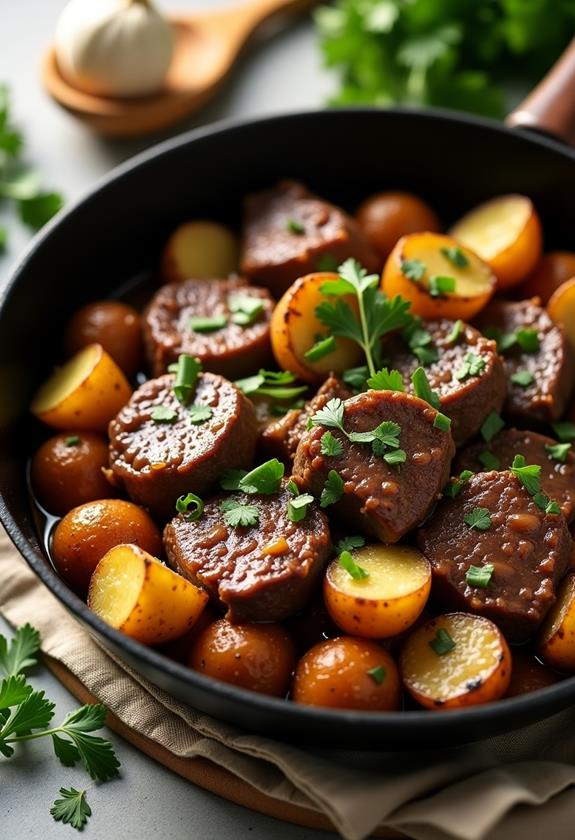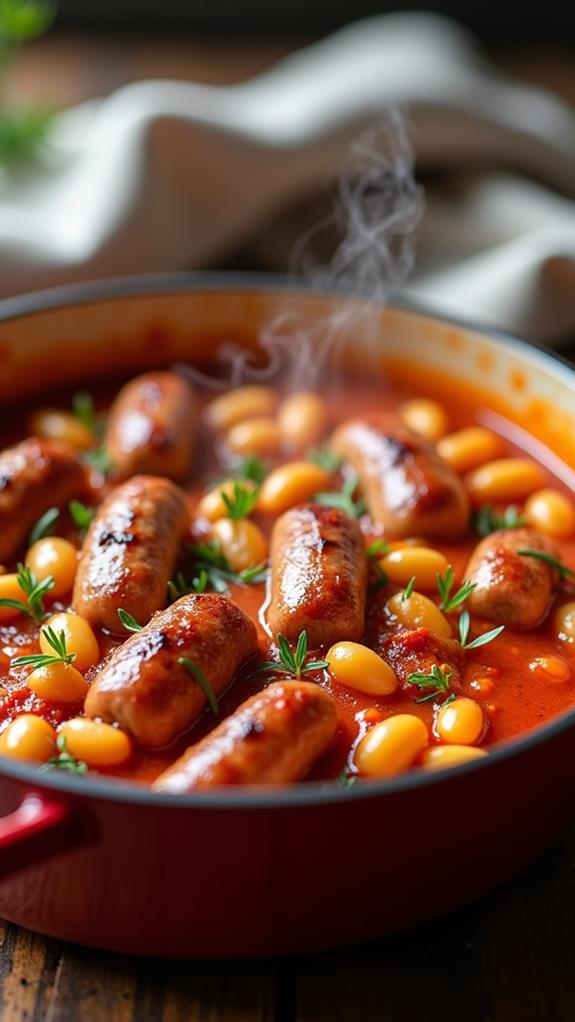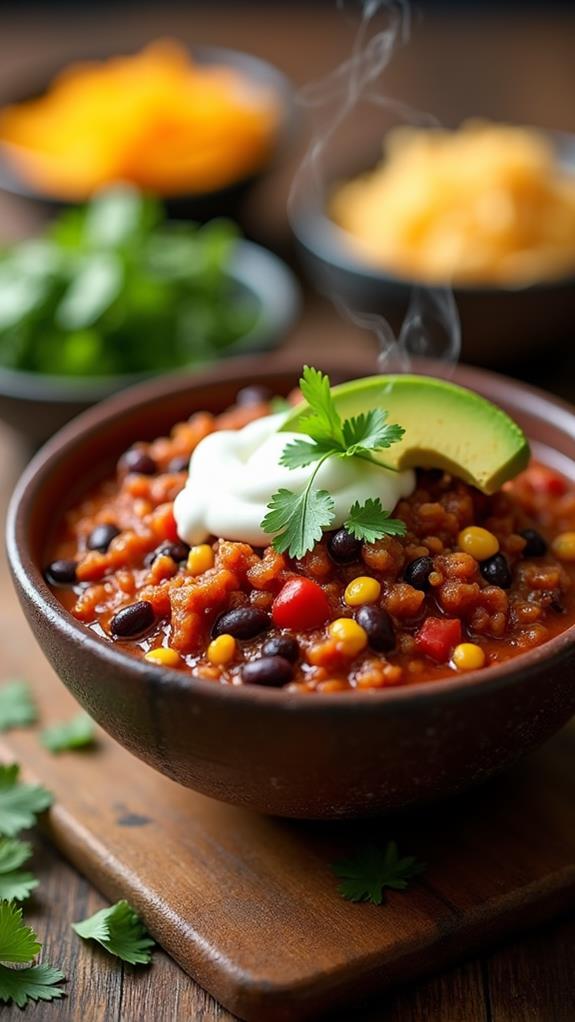Vegetable Beef Soup Recipe

Nothing beats the comfort of a hearty, homemade vegetable beef soup on a chilly day. This soul-warming recipe combines tender chunks of beef with fresh vegetables in a rich, flavorful broth that will fill your kitchen with irresistible aromas.
Perfect for feeding a crowd or meal prepping for the week, this vegetable beef soup is both nutritious and satisfying. Follow my step-by-step guide to create a bowl of pure comfort that will become a family favorite for years to come.
What is “Vegetable Beef Soup”?
Vegetable beef soup is a classic comfort food that combines cubed beef, mixed vegetables, and aromatic herbs in a savory broth. This hearty soup has been a staple in American kitchens for generations, offering a perfect balance of protein, vegetables, and warming spices. The beauty of this dish lies in its versatility – you can customize it with seasonal vegetables or whatever you have on hand.
The key to exceptional vegetable beef soup is browning the beef first to develop deep flavors, then slowly simmering everything together until the meat becomes fork-tender and the vegetables are perfectly cooked. The result is a satisfying meal that’s both nutritious and delicious.
Ingredients List for Vegetable Beef Soup
- 2 pounds beef stew meat, cut into 1-inch cubes
- 2 tablespoons olive oil
- 1 large onion, diced
- 3 carrots, peeled and sliced
- 3 celery stalks, chopped
- 4 cloves garlic, minced
- 8 cups beef broth
- 1 can (14.5 oz) diced tomatoes
- 2 medium potatoes, cubed
- 1 cup green beans, trimmed and cut into 1-inch pieces
- 1 cup frozen corn kernels
- 1 cup frozen peas
- 2 tablespoons tomato paste
- 1 teaspoon dried thyme
- 1 teaspoon dried oregano
- 2 bay leaves
- 1 teaspoon salt (or to taste)
- ½ teaspoon black pepper
- 2 tablespoons fresh parsley, chopped (for garnish)
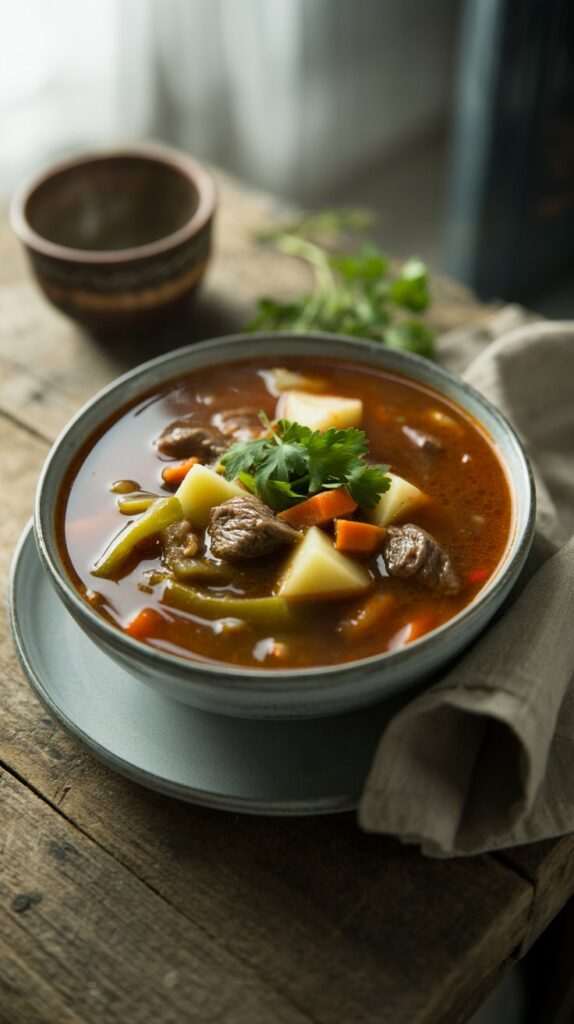
How to Cook Vegetable Beef Soup: A Step-by-Step Guide
Creating the perfect vegetable beef soup requires patience and attention to detail. Here’s my comprehensive guide to ensure your soup turns out perfectly every time:
1. Prepare Your Ingredients:
- Cut the beef into uniform 1-inch cubes for even cooking.
- Dice all vegetables to similar sizes so they cook at the same rate.
- Having everything prepped before you start cooking makes the process much smoother.
2. Brown the Beef:
- Heat olive oil in a large, heavy-bottomed pot or Dutch oven over medium-high heat.
- Season the beef cubes with salt and pepper before adding them to the pot.
- Brown the beef in batches, ensuring not to overcrowd the pot.
- This step typically takes 8-10 minutes total and creates a flavorful foundation for your soup.
3. Sauté the Aromatics:
- In the same pot, add diced onions, carrots, and celery.
- Cook for 5-7 minutes until the vegetables begin to soften and the onions become translucent.
- Add minced garlic and cook for another 30 seconds until fragrant.
4. Build the Base:
- Stir in tomato paste and cook for 1-2 minutes to develop its flavor.
- Add the diced tomatoes with their juices, scraping up any browned bits from the bottom of the pot.
- Return the browned beef to the pot along with any accumulated juices.
5. Add Liquid and Seasonings:
- Pour in the beef broth, ensuring the liquid covers all ingredients by about 1 inch.
- Add thyme, oregano, and bay leaves for aromatic depth.
- Bring the mixture to a boil, then reduce heat to low and simmer covered.
6. Long, Slow Simmer:
- Allow the soup to simmer for 1.5 to 2 hours, stirring occasionally.
- The beef should become fork-tender during this time.
- Taste and adjust seasonings as needed.
7. Add Remaining Vegetables:
- Add cubed potatoes and green beans to the pot.
- Continue simmering for 15-20 minutes until potatoes are tender.
- Stir in frozen corn and peas during the last 5 minutes of cooking.
8. Final Touches:
- Remove bay leaves before serving.
- Taste and adjust salt and pepper as needed.
- Garnish with fresh chopped parsley for a burst of color and freshness.
Substitutions and Variations
Vegetable beef soup is wonderfully adaptable to your preferences and what’s available in your pantry. Here are some excellent substitutions and variations:
- Beef: Replace stew meat with ground beef for a quicker cooking time, or use leftover roast beef added during the last 30 minutes.
- Vegetables: Swap green beans for zucchini, add mushrooms, or include parsnips for different flavors and textures.
- Broth: Use vegetable broth for a lighter taste, or combine beef and chicken broth for complexity.
- Grains: Add pearl barley, rice, or small pasta shapes to make the soup more filling.
- Herbs: Fresh herbs like rosemary or sage can replace dried herbs for a more vibrant flavor.
- Spice Level: Add a pinch of red pepper flakes or a dash of hot sauce for those who enjoy heat.
Common Mistakes to Avoid
When making vegetable beef soup, avoid these common pitfalls to ensure the best results:
- Skipping the Browning Step: This crucial step develops deep, rich flavors that can’t be achieved any other way.
- Cutting Vegetables Too Small: Tiny pieces will become mushy during the long cooking time.
- Adding All Vegetables at Once: Different vegetables have different cooking times; add them accordingly.
- Not Seasoning in Layers: Season the beef before browning and taste throughout the cooking process.
- Rushing the Cooking Process: Low and slow is the key to tender beef and well-developed flavors.
- Forgetting to Remove Bay Leaves: Always remove them before serving as they can be unpleasant to bite into.
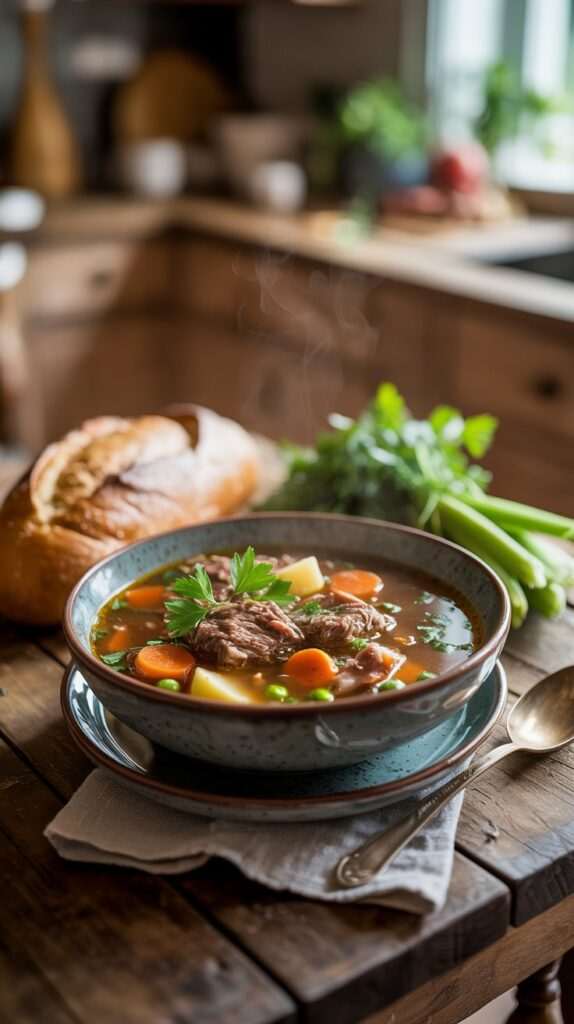
How to Serve Vegetable Beef Soup
Vegetable beef soup makes an excellent main course that can be served in various ways. I love serving it with crusty sourdough bread or warm dinner rolls for dipping. A simple side salad with mixed greens provides a fresh contrast to the hearty soup.
For a more substantial meal, serve the soup over cooked rice or with grilled cheese sandwiches. The combination of creamy cheese and rich soup is absolutely divine. Don’t forget to provide soup spoons and plenty of napkins – this is comfort food at its finest!
Presentation Ideas for Vegetable Beef Soup
Make your vegetable beef soup look as good as it tastes with these presentation suggestions:
- Rustic Bowls: Serve in deep, wide bowls that showcase the colorful vegetables and tender beef.
- Fresh Herb Garnish: Top each bowl with freshly chopped parsley, thyme, or chives for a pop of color.
- Crusty Bread Accompaniment: Place a slice of toasted bread on the side of each bowl for an Instagram-worthy presentation.
- Drizzle of Oil: A light drizzle of high-quality olive oil on top adds visual appeal and enhances flavor.
Vegetable Beef Soup Recipe Tips
Here are my top tips for making the most delicious vegetable beef soup:
- Choose the Right Cut: Chuck roast or beef stew meat works best due to their marbling and collagen content.
- Don’t Skip the Resting Time: Let the soup sit for 10-15 minutes before serving to allow flavors to meld.
- Taste and Adjust: Always taste your soup before serving and adjust seasonings accordingly.
- Make It Ahead: This soup actually tastes better the next day as flavors continue to develop.
- Freeze Smart: Cool completely before freezing, and leave some room for expansion in containers.
- Quality Broth Matters: Use low-sodium beef broth so you can control the salt content.
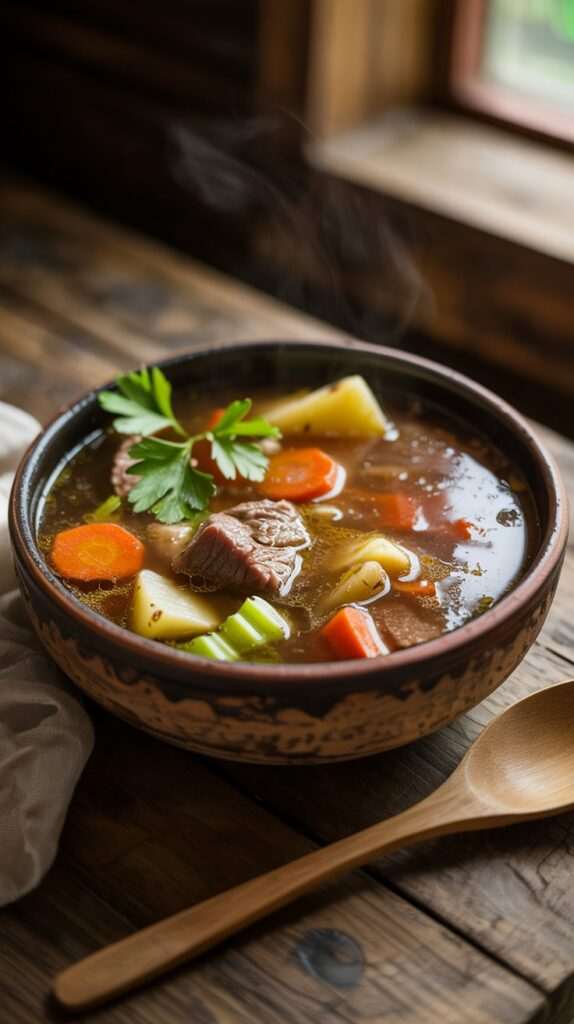
How to Store Vegetable Beef Soup
Proper storage ensures your vegetable beef soup maintains its quality and safety. Allow the soup to cool completely before transferring to airtight containers. Store in the refrigerator for up to 4 days or freeze for up to 3 months.
When reheating, warm gently on the stovetop over medium-low heat, stirring occasionally. You may need to add a bit of broth or water if the soup has thickened during storage. Always ensure the soup reaches a safe internal temperature of 165°F before serving.
Frequently Asked Questions (FAQs)
Q: Can I make vegetable beef soup in a slow cooker?
A: Absolutely! Brown the beef first, then transfer everything to a slow cooker. Cook on low for 6-8 hours or high for 3-4 hours. Add quick-cooking vegetables like peas and corn during the last 30 minutes.
Q: How can I thicken my vegetable beef soup?
A: Mix 2 tablespoons of flour with cold water to create a slurry, then stir it into the simmering soup. Alternatively, mash some of the potatoes against the side of the pot to naturally thicken the broth.
Q: Can I use frozen vegetables instead of fresh?
A: Yes, but add frozen vegetables during the last 10-15 minutes of cooking to prevent them from becoming mushy.
Q: What’s the best way to cut the beef for even cooking?
A: Cut against the grain into uniform 1-inch cubes. This ensures tender pieces that cook evenly throughout.
Q: Can I make this soup without tomatoes?
A: Certainly! Simply omit the diced tomatoes and tomato paste. You might want to add an extra cup of broth to maintain the liquid ratio.
Q: How do I know when the beef is tender enough?
A: The beef should easily fall apart when pierced with a fork. This usually takes 1.5-2 hours of simmering.
Conclusion
Vegetable beef soup is more than just a meal – it’s a warm hug in a bowl that brings families together around the dinner table. This hearty, nutritious soup combines simple ingredients into something truly special, perfect for cold winter nights or whenever you need comfort food.
The beauty of this recipe lies in its flexibility and forgiving nature. Whether you follow it exactly or make it your own with personal touches, you’ll end up with a satisfying soup that fills both stomach and soul. Take your time with the cooking process, enjoy the wonderful aromas filling your kitchen, and savor every spoonful of this timeless classic.
Remember, the best vegetable beef soup is made with love, patience, and quality ingredients. So gather your family, ladle up some bowls, and enjoy this delicious reminder that sometimes the simplest dishes are the most memorable. Happy cooking!


